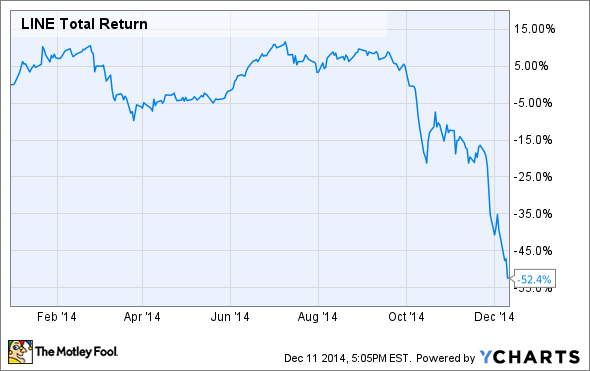If you are a shareholder in LINN Energy (LINEQ) and haven't looked at the stock market lately, then I would advise you to get a barf bag because the following chart might make you nauseous.
LINE Total Return Price data by YCharts
The recent oil price plunge has wreaked havoc on energy stocks, and thanks to LINN's position as a master limited partnership that produces oil and gas, it has taken it particularly hard on the chin. For those of you who have suffered through this recent price plunge, I have been right there with you. I'm not that worried about my ownership in the company, yet. Let's take a look at why LINN is in an OK position to weather the storm for a while, and when you should really start to worry about this company.
Strength of hedging
Simply pointing out that the company has a large portion of its production hedged for 2015 and 2016 is a pretty tried and true method for defending shares of LINN lately. According to the company, it has at least 60% of its oil production hedged at a selling price of greater than $94 per barrel.

Source: LINN Energy Investor Presentation.
Still, 40% of its oil unhedged might make some investors nervous that LINN can't meet its distribution obligations. So let's do some back-of-the-napkin calculations to determine what kind of impact this might have in the upcoming year. To do so, here are some assumptions we'll work off of:
- Management doesn't change its drilling program to reduce oil exposure, its FY 2014 guidance looks the same in 2015, and hits the high side of guidance. This will impact the company the most in terms of selling cheap oil.
- The average unhedged price LINN sells for all of 2015 is at today's prices -- just above $60 per barrel for West Texas Intermediate.
- All natural gas liquids will be sold at 40% the price of oil, as the company's guidance says.
Here is the company's guidance numbers for 2014.

Source: LINN Energy Investor Presentation.
Based on these numbers and the assumptions we made above: Revenue for 2015 would come in at $3.5 billion, with more than $2.6 billion of it coming from hedged positions in natural gas and oil. On the cost side, LINN estimates that total cash costs -- which is excluding depreciation -- will be around $2.9 billion. This means that total cash available to shareholders would be about $600 million for the year.
Considering that the company wants to pay out $962 million in distributions next year, it will be about $360 million short, give or take. While that does sound discouraging -- that's a projected distribution coverage ratio of 0.65 -- it doesn't factor in any asset sales that could be used to cover the short fall. Also, while that may not be the worst-case scenario for the company, it's a pretty conservative estimate to assume that management won't shift its capital budget and that oil remains at $60 per barrel for the entirety of 2015.
Let's keep in mind, though, that these are pretty rough calculations. There is a bit of room at the margins for these numbers to change, so don't take them as the gospel.
When to really worry?
The company can likely survive a year with oil at around $60 per barrel without inflicting too much pain. LINN's management already has a decent-sized position in the Permain Basin held for sale, and a similar amount of acreage sold for $350 million back in October, which could help cover any major shortfalls. Also, I would like to think that management will adjust its capital expenditures to spend a little less on oil production to keep costs down.
If we were to head into 2016 without much improvement in oil prices, though, then it might be time to start reconsidering a position in LINN. It's hedged position for 2016 looks pretty similar to its 2015 position, but if oil stays low all the way through 2015 and 2016, then we're looking at a point where LINN will have to lock in some rather unfavorable prices for beyond that.
What a Fool believes
I have no delusions that LINN will go through this major dip in oil prices without being affected in one way or another. However, the projected cash shortfall for its distributions isn't so severe that the company could go broke. I am, however, going to keep a keen eye on what oil prices do throughout 2015, and how management reacts to the situation. Realistically, LINN needs oil prices around $85 to make its current budget. So if oil prices can get within that range, then I'm going to sleep soundly. Anything less than that, though, and it may be time to move on.






